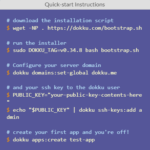Salesforce.com’s acquisition of PaaS provider Heroku was a focal point of this year’s Dreamforce conference in San Francisco. At that event, Heroku opened beta access to Java developers on its formerly Ruby-only platform-as-a-service. This week, VMware’s VMworld conference is taking place in Las Vegas, and the combination of announcements from the two companies shows that both are on a course for increased competition.
Just over a year ago, Salesforce and VMware were making joint announcements. Known as VMforce, the two companies told customers that they would be collaborating to blend private and public clouds into a single entity. That project was killed just before the Heroku acquisition by Salesforce, with VMware rumored to have been outbid for it.
VMware, which is also holding its conference this week, announced its own PostgreSQL-based cloud database product. VMware’s announcements bring it up to par with services now offered by Heroku. The Heroku PaaS already offers PostgreSQL databases to Ruby developers, though its services are available only in its cloud. VMware’s private cloud offering, known as vFabric Data Director, will offer on-demand database capabilities to enterprises using the vSphere system in private clouds.
Al Hilwa, program director for application development software at IDC, said that “PostgreSQL appears to be this week’s cloud darling, but enterprises will likely wait to see what the entrenched enterprise databases like Oracle, DB2 and SQL Server can offer them in terms of ease of migration and support before they bring these workloads to the cloud.”
On the PaaS side of the coin, VMware has been hyping Cloud Foundry, which seeks to support popular Java frameworks in a deployable PaaS environment. Heroku’s announcement of beta support for Java brings similar capabilities to its hands-off approach toward PaaS.
Byron Sebastian, general manager of Heroku, said that Java was chosen as the first new language supported on the previously Ruby-only service due to customer demand. “I would say it’s not a goal to go down a list of all the languages. It’s a goal to support the languages our customers are asking for. Most importantly, to support the languages people are using for cloud applications,” he said.
“We have a unique position to see what applications people want to build in the cloud and where the demand is from developers, and to make sure they have the variety of tools they need.”
VMware also released this week is a beta version of Cloud Foundry targeted at desktop use, giving developers a place to test their software without leaving their desktops.
But for actual internal deployments, vFabric Data Director is designed to make the provisioning of databases inside an enterprise self serviceable. VMware is charging US$600 per virtual machine instance, which includes management tools to make the mundane and difficult administrative tasks databases require easier to perform. It also includes instance templates for common uses.
“There’s a self-service interface that allows a developer to request one of those database templates,” said David McJannet, VMware’s director of product marketing for SpringSource. “But there’s not only this centralized management and self provisioning concept, there is integration with vSphere.”
Though self-service and internal clouds are clearly the focus of VMware’s new products, Salesforce is pushing its cloud services as alternatives to running internal applications. For this reason, the two companies are increasingly competing or preparing to compete with one another. While Salesforce expands its Force.com platform, VMware is preparing its Cloud Foundry as an open and more flexible alternative.
In addition to the PaaS announcements from this week’s conference, Marc Benioff, CEO of Salesforce, announced the new Database.com Data Residency Option. This will allow developers building applications inside Salesforce to use data hosted within private data centers.
“This lets you take data in your data center and include it in your Salesforce.com applications,” he said. “It doesn’t have to be in our data center; it can be in your data center. We can continue to provide our updates and changes, but if there is key data in your data center, and you have a policy against hosting the data outside, or there’s a government policy issue, now you have the ability to keep that data in your data center.”
“Force.com is an amazingly powerful platform that has a huge amount of adoption, and it’s been amazing to get to know them in my new role,” said Sebastian. “Customers range from large conservative organizations, all the way to the newest and rapidly growing companies. The reason they’re picking Force.com, in addition to the fact that it’s a great platform and it abstracts away servers, is that it provides a great development model for rapid development of data-driven applications that are form and table driven.”
Though the two business models may be different, the fundamental goal is still the same for each: enable Java developers to build and run their applications in the cloud, and offer databases as a service. The only real difference between the two companies is where they hope to offer their solutions: VMware aims for private clouds; Salesforce hosts its own public cloud. And as the lines between those two continue to blur, as they do with the Database.com Data Residency Option, the two firms will move further and further away from the now long dead camaraderie they showed only a year ago.
Hilwa said that the PaaS wars are all about developers. “From the PaaS wars, we are seeing from the announcements that there is a huge battle for the hearts and minds of application developers. There is a major transformation taking place in application platforms, and everybody is fighting to paint a vision of what things will look like when all settles down. We are drifting into a more diverse world where there are many languages and platforms available to developers in a viable way,” he said.






